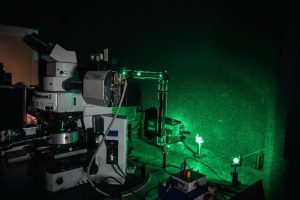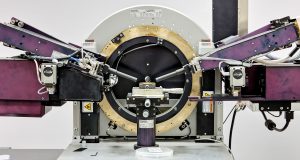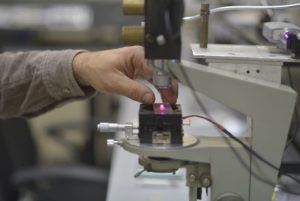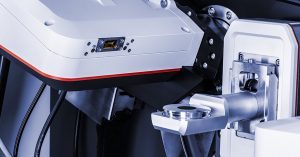
Title: "Reinvention of the diagnostic algorithm and treatment options for reactivated toxoplasmosis"
(Acronym: ToxoReTREAT)
Program: PRISMA
Sub-program: Biomedical sciences
Project No: 7328
Project duration: 01.12.2023. - 30.11.2026.
Leading institution: Institute for Medical Research, National Institute of Republic of Serbia, University of Belgrade (IMI), Serbia
Principal investigator: Dr Tijana ŠTAJNER, Institute for Medical Research, National Institute of Republic of Serbia, University of Belgrade (IMI), Serbia
Partnering institutions:
- Faculty of Medicine, University of Belgrade (MFUB), Belgrade, Serbia
- Faculty of Pharmacy, University of Belgrade (FPHUB), Belgrade, Serbia
- Institute of Physics Belgrade (IPB), Univ. of Belgrade, Belgrade, Serbia
Participants from IPB: Dr Andjelija ILIĆ, Jelena TRAJKOVIĆ


Selected publication: https://doi.org/10.3390/fractalfract8030175

Title: Elimination of respirable airborne particles, microplastics, microorganisms, and VOCs by ionization of indoor air and filtration systems: comprehensive investigation for reliable technological answers (Acronym: IonCleanTech)
Program: Green Program of Cooperation between Science and Industry
Project number: 5661
Project duration: 15.05.2023. - 14.05.2025.
Principal investigator: Dr Predrag KOLARŽ, Institute of Physics Belgrade, Pregrevica 118, 11080 Belgrade, Serbia
Partnering institutions:
- School of Medicine, University of Belgrade, Belgrade, Serbia
- School of Veterinary Medicine, University of Belgrade, Belgrade, Serbia
Participants from IPB: Dr Predrag KOLARŽ, Dr Andjelija ILIĆ, Dr Mira ANIČIĆ UROŠEVIĆ, Jelena TRAJKOVIĆ
Project website: https://ioncleantech.my.canva.site/home

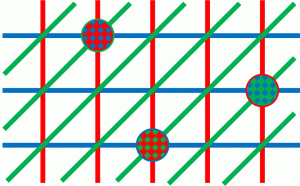
Title: "Nano-objects in own matrix – Self composite" (NOOM – SeC)
Program: IDEJE, Science Fund of the Republic of Serbia
Project duration: 2021 - 2024
PI: Dr Nebojša Romčević
With this project, a completely new type of the composite material, Self composite, will be introduced. A nanocomposite is a multiphase solid material where at least one of the phases has one, two or three dimensions of less than 100 nm. Nano-objects, such as nanoparticles, nanofiber and nanoplate, have the potential to revolutionizes the performance of materials and structures. However, their small scale means their (nano-objects) behavior is fundamentally different to that of bulk materials.
Our idea and goal is to produce Self composite in which the dispersed phase is in the nanometric size, with the specificity that the nano-object are formed from the same material, or its parts, such as matrix. Matrix is a multicomponent solid solution or compound which is formed from, for example, two binary components AB and AC. Monocrystal solid solution AB1-xCx, or similar compound, do not exist for every value of x, i.e., the solubility of one phase into the other is limited. The excess of component AC in the starting mixture (over the limit of its solubility) will cause the formation of the solid solution matrix AB1-xCx with the dispersed AC phase in the form of the nano-objects.
Self composites will be produced by using standard methods for the monocrystal growth – Czochralski and Bridgman. Molecular beam epitaxy will be used for the preparation of the thin films. Expected result of the Project is to produce the following self composites (matrix/nano-objects): Bi12GeO20/Bi2O3, Bi12GeO20/GeO2, Bi12SiO20/Bi2O3, Bi12SiO20/SiO2, Cd1-xFexTe1−ySey/FeTe, Pb0.88Mn0.12Te/MnTe, Cd1-xMnxTe/MnTe, Cd1-xMnxGeAs2/MnAs, Zn1-xMnxSnAs2/MnAs, Cd1-xMnxSnAs2/MnAs, Pb1-xSixSeyTe1-y/SiTe, Pb1-x-ySixGdyTe/GdTe. Synthesized self composites will be characterized and results will be analyzed in the frame of the effective medium theory. Functionality and potential application of these materials in the optics, magneto-optics, and in the field of the thermoelectric materials will be examined.

Title: „Strain Effects in Iron Chalcogenide Superconductors“ (StrainedFeSC)
Program: PROMIS, Science Fund of the Republic of Serbia
Project duration: 2020 - 2022
PI: Dr Nenad Lazarević
Project website: Strained FeSC (ipb.ac.rs)
Discovery of superconductivity in the Fe-based materials (FeBSCs) in 2008 brought new excitement in the field of high-Tc superconductors. It gave us new clues in the decades-long struggle for deciphering the mystery behind the high-Tc superconductors. Although much has been learned since, some of the key questions regarding the complex interplay between lattice, magnetism and superconductivity, are still controversial. While posing the challenge, close proximity of the phases in FeBCS can be facilitated through tuning of their properties by applying strain as an additional control parameter. Access to the various degrees of freedom can provide the valuable data needed, not only for pinpointing the generic properties and, possibly, understanding of the FeBSCs, but also for material/device engineering.

(a) Symmetry properties and momentum dependencies of the Raman vertices. Shown are the first and second order vertices for polarization orientations transforming as A1g, B1g and B2g symmetries of the D4h space group. The solid lines represent an idealized two-band Fermi surface of FeBSCs in the 1 Fe unit cell. (b) Phenomenological decomposition of the FeSe B1g Raman data at three characteristic temperatures.
Inelastic scattering of visible light (Raman effect) has the capability to simultaneously probe lattice, charge and spin excitations as well as their mutual interactions and is well established as an indispensable tool for research into high-Tc superconductors. The respective symmetry selection rules allow one to pin down the type of excitation and to get k-resolved information about the electrons [see Fig. (a)]. Through the linear combinations of spectra, measured for different polarization configurations, pure symmetry spectra are calculated [see Fig. (b)]. By varying parameters such as temperature and strain, valuable data incisive for understanding of these (multi-band) systems can be obtained.
While being the member of the FeBSC family with the simplest crystallographic structure, FeSe represents a fascinating example of the interplay between the phases. The superconducting transition temperature ranges from 8.9 K in the bulk to almost 100 K for a monolayer on SrTiO3. This huge increase in Tc was traced back to the combination of different pairing mechanisms.
In the pure B1g symmetry of FeSe single crystals Raman spectra, aside from the response from particle-hole excitations, a strong contribution at energies of order kBT is observed with spectral weight peaking at the nematic phase transition [see Fig. (b)]. Currently, it is not settled whether the fluctuations observed by light scattering are related to spin or charge. Another controversy is about possible two-magnon excitations at about 500 cm-1. Whilst this response can also originate from charge excitations, as in most of the Fe-based compounds, theory and experiment suggest that the observed high-energy excitations can be traced back to localized spins in a nearly frustrated system. If these controversies could be settled, the driving force behind the phase transitions in iron-chalcogenides would be identified.
Title: "2D Material-based Tiled Network Films for Heritage Protection" - 2DHeriPro
Program: PRIZMA, Science Fund of the Republic of Serbia
Project duration: 2023. - 2026.
PI: Dr Tijana Tomašević-Ilić
Project web site: 2DHeriPro (ipb.ac.rs)
Protecting cultural heritage from deterioration is a challenge recognized by the international community and represented by one of the 169 UN specific targets. Due to the implications in identity, history, and economy, heritage decay affects all society in general. Our multidisciplinary approach covers the development of new materials in response to real conservation needs, testing such materials, and assessing their heritage impact. The core of the 2DHeriPro consists in developing ultrathin films from 2D materials, compatible with the composition, color, and texture of historical remains, produced in an inexpensive and scalable method, that offers long-term protection against external influences recognized as key parameters of heritage deterioration. The proposed research will make a scientific breakthrough in understanding physical and chemical processes governing the novel 2D material films to address the conservation of wall paintings and decorative mortar used by both traditional and contemporary artists. Expected results of the project are to provide a deep insight into the interaction of the new generation of 2D materials with the environment and establish a new database that will set the path for the future architecture of 2D-based materials that can be used for building durable protective coatings.

Title: "Dynamics of CDW transition in strained quasi-1D systems" - DYNAMIQS
Program: PROMIS
Project duration: 2023. - 2025.
PI: Ana Milosavljević
Quasi-low dimensional materials that exhibit both charge density wave and superconducting states, offer a unique platform to investigate the interplay between these two phenomena and explore their quantum properties. Such materials provide opportunities for developing advanced devices with multifunctional capabilities, where charge density wave and superconductivity can be controlled and tuned. By gaining a deeper understanding of how mechanical deformation influences these properties, we can unlock their potential for customized functionalities, and contribute to the development of innovative field of (opto)electronic devices, advanced sensor technologies, energy conversion systems, and quantum computing.
DYNAMIQS Project is focused on tuning Fermi surface instabilities in transition metal trichalcogenides, specifically ZrTe3 and its derivatives, ZrTe3-xSex, Zr1-xHfxTe3, CuxZrTe3 and NixZrTe3 by application of an uniaxial strain field. By utilizing strain, our aim will be to optimize desired physical properties and gain insights into the interplay between lattice, spin, and charge excitations. We will employ inelastic light scattering setup, and study these excitations simultaneously as a function of external parameters such as temperature and the symmetry breaking strain field.
 Title: "Continuous inactivation and removal of SARS-CoV-2 in indoor air by ionization" (Acronym: idCOVID)
Title: "Continuous inactivation and removal of SARS-CoV-2 in indoor air by ionization" (Acronym: idCOVID)
Program: Special research program on COVID-19, Science Fund of the Republic of Serbia
Project duration: 01.02.2021. - 31.05.2022.
Principal investigator: Dr Predrag KOLARŽ,
Institute of Physics Belgrade, Pregrevica 118, 11080 Belgrade, Serbia
Partnering institution: School of Medicine, University of Belgrade, Belgrade, Serbia
Participants from IPB: Dr Predrag KOLARŽ, Dr Andjelija ILIĆ, Dr Saša ĆIRKOVIĆ, Dr Mira ANIČIĆ UROŠEVIĆ, Dr Jasna RISTIĆ-DJUROVIĆ, Dr Nebojša ROMČEVIĆ
Project website: http://idcovid.ipb.ac.rs/Index.pdf
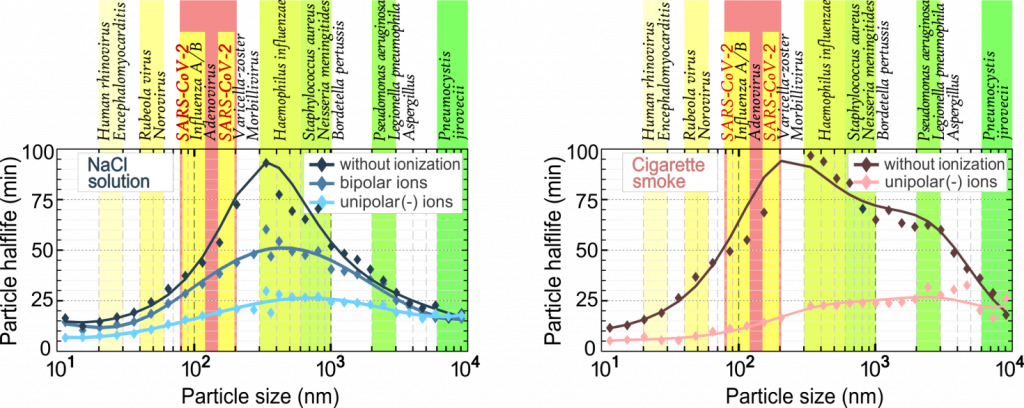
Selected publication: https://doi.org/10.1016/j.jaerosci.2023.106199
Title: „Nanometer thin photovoltaics based on plasmonically enhanced van der Waals heterostructures“, PV-Waals
Program: PROMIS, Science Fund of the Republic of Serbia
Project duration: 2020 - 2022
PI: Dr Goran Isić
Project website: https://pv-waals.com/

